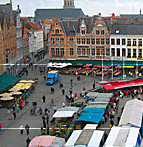Discovering authentic Belgian cuisine in Bruges requires navigating beyond the tourist-focused establishments that line the Markt square toward the hidden gems where locals dine and culinary traditions flourish. With over 8 million visitors annually, the medieval city presents both incredible dining opportunities and potential tourist traps, making insider knowledge essential for memorable meals that showcase Belgium's renowned culinary heritage.
Belgian cuisine extends far beyond the famous waffles and chocolate that attract international attention, encompassing rich stews, exceptional seafood, artisanal cheeses, and an incredible beer culture that pairs perfectly with hearty, flavorful dishes. The key to exceptional dining in Bruges lies in understanding where locals eat, when restaurants serve their best dishes, and how to identify establishments that prioritize quality over convenience for tourist crowds.
Avoiding Tourist Traps: Smart Dining Strategy
The Markt Square Reality: While the restaurants directly facing the Markt square offer unbeatable views of the medieval architecture and the towering Belfry, they typically charge premium prices for standard food that caters to international tastes rather than showcasing authentic Belgian flavors. These establishments bank on location rather than culinary excellence, often serving reheated meals and overpriced beverages to tourists who prioritize convenience over quality.
Smart diners venture just one or two streets away from the main square to discover family-run establishments that have served the local community for generations. These restaurants maintain authentic recipes, source ingredients from regional suppliers, and offer genuine hospitality that reflects Belgian dining culture. The short walk from the tourist center often results in significant savings and dramatically improved food quality.
Local Dining Hours and Customs: Belgian restaurants typically serve lunch from 12:00 PM to 2:30 PM and dinner from 6:00 PM to 9:30 PM, with many closing between lunch and dinner service. Understanding these hours prevents disappointment and allows you to plan restaurant visits around attraction schedules. Many local establishments close on Mondays or Tuesdays, particularly family-run restaurants that prioritize work-life balance.
Traditional Belgian Cuisine: Must-Try Dishes
Carbonnade Flamande: This quintessential Flemish stew represents the heart of Belgian comfort food, featuring tender beef slowly braised in Belgian beer until it achieves melt-in-your-mouth perfection. The dish showcases the Belgian mastery of combining beer with cooking, creating complex flavors that develop through patient preparation. Authentic versions use local abbey beers and are served with crispy Belgian fries and a selection of mustards that complement the rich, savory flavors.
The best carbonnade flamande requires hours of careful cooking, with each restaurant developing its own signature approach to seasoning and beer selection. Look for establishments that prepare this dish fresh daily rather than keeping it warm for extended periods. The aroma alone should tell you when you've found an authentic preparation—rich, complex, and inviting in a way that speaks to generations of culinary tradition.
Moules-frites (Mussels and Fries): Belgium's coastal location provides access to exceptional North Sea mussels, prepared in various styles that highlight the natural sweetness of these fresh shellfish. Traditional preparations include white wine and herb broths, cream-based sauces, and Belgian beer reductions that create flavorful bases for the tender mussels. The accompanying fries, cut thick and double-fried to achieve crispy exteriors and fluffy interiors, represent the pinnacle of Belgian fry-making artistry.
Seasonal availability affects mussel quality, with the best specimens available from September through April when North Sea waters are cooler and mussels reach peak flavor. Restaurants that source directly from Belgian coast suppliers often display daily catch information, indicating their commitment to freshness and quality. The traditional serving style includes empty shell bowls for discarded shells and small forks specifically designed for extracting mussels from their shells.
Waterzooi: This creamy chicken or fish stew originated in nearby Ghent but has become a beloved dish throughout Belgium, including many excellent preparations in Bruges. The dish combines tender protein with vegetables in a rich, cream-based broth that provides comfort and satisfaction. Traditional versions feature local fish or free-range chicken, seasonal vegetables, and herbs that create layers of flavor without overwhelming the main ingredients.
Fine Dining and Upscale Experiences
Michelin-Level Excellence: Bruges attracts renowned chefs who combine traditional Belgian techniques with contemporary presentations, creating dining experiences that rival Europe's most celebrated culinary destinations. These restaurants source the finest local ingredients, maintain extensive wine cellars featuring both Belgian and international selections, and provide service that transforms meals into memorable experiences.
Reservations at top-tier establishments require advance planning, particularly during peak tourist seasons and weekends when demand from both visitors and locals creates competition for tables. Many fine dining restaurants offer tasting menus that showcase seasonal ingredients and the chef's interpretation of Belgian culinary traditions, providing comprehensive introductions to regional flavors and techniques.
Wine and Beer Pairing Culture: Belgian restaurants excel at beverage pairings, offering extensive selections of local beers alongside carefully curated wine lists that complement both traditional and contemporary dishes. Knowledgeable staff can guide diners through pairing options, explaining how different beer styles enhance specific flavors and why certain wines work particularly well with Belgian cuisine.
The Belgian beer tradition includes abbey ales, lambics, and specialty brews that many restaurants pour with ceremony and attention to proper glassware. Each beer style has specific serving temperatures and glass shapes that maximize flavor and aroma, creating drinking experiences that match the sophistication of the cuisine.
Casual Dining and Local Favorites
Neighborhood Brasseries: These casual establishments form the backbone of Belgian dining culture, serving hearty portions of traditional dishes in relaxed atmospheres where locals gather for both meals and social interaction. Family-run brasseries often feature recipes passed down through generations, with preparation methods that prioritize flavor and tradition over modern presentation techniques.
The atmosphere in authentic brasseries reflects Belgian hospitality, with servers who take pride in explaining dishes, recommending beer pairings, and ensuring guests feel welcomed rather than rushed. Many feature dark wood interiors, vintage beer advertisements, and the comfortable buzz of regular customers who treat these establishments as community gathering places.
Café Culture and Light Meals: Belgian cafés serve more than beverages, offering light meals, sandwiches, and snacks that provide excellent value and authentic flavors. These establishments often specialize in regional cheeses, artisanal breads, and simple preparations that highlight quality ingredients. The café culture encourages lingering, people-watching, and experiencing daily life in Bruges beyond the tourist attractions.
Traditional café fare includes croque-monsieur prepared with local ham and cheeses, soup of the day featuring seasonal ingredients, and various tartines (open-faced sandwiches) that showcase Belgian culinary creativity. Many cafés maintain relationships with local bakeries, cheese makers, and other artisanal suppliers, ensuring fresh, high-quality ingredients in even simple preparations.
Budget-Friendly Authentic Options
Student Quarter Discoveries: Areas near local schools and residential neighborhoods offer excellent value dining with authentic flavors that cater to locals rather than tourists. These establishments often serve generous portions at reasonable prices while maintaining quality that reflects Belgian culinary standards. Daily specials frequently feature seasonal ingredients and traditional preparations at prices that encourage regular local patronage.
Lunch specials in these areas provide particular value, with set menus that include multiple courses for prices significantly lower than tourist-area restaurants. The informal atmosphere and local clientele create opportunities to experience authentic Belgian dining culture while staying within budget constraints.
Market Day Opportunities: The Wednesday and Saturday markets in the Markt square provide access to local ingredients, artisanal products, and prepared foods that showcase regional specialties. Vendors often offer samples, explain production methods, and provide insights into Belgian food culture that enhance appreciation for local cuisine.
Fresh bread, local cheeses, seasonal produce, and specialty items from the markets create opportunities for picnic-style meals that can be enjoyed in parks, along canals, or in other scenic locations throughout Bruges. This approach combines budget-conscious dining with authentic local flavors while providing flexibility in meal timing and location.
Seasonal Specialties and Food Events
Spring and Summer Offerings: Warmer months bring outdoor dining opportunities, seasonal produce, and lighter preparations that take advantage of longer daylight hours and pleasant weather. Restaurants expand to terraces and outdoor seating areas that provide al fresco dining experiences with views of medieval architecture and canal-side settings.
Spring menus often feature fresh asparagus, early vegetables, and preparations that celebrate the renewal of local growing seasons. Summer brings outdoor markets with peak seasonal produce, extended dining hours, and festival atmospheres that make meals feel more like celebrations than simple sustenance.
Autumn and Winter Comfort: Cooler months emphasize hearty stews, rich sauces, and warming dishes that provide comfort during shorter days and challenging weather. This season showcases Belgian cuisine at its most traditional, with game meats, root vegetables, and preservation techniques that reflect centuries of culinary evolution.
Winter dining includes indoor warmth, candlelit atmosphere, and the famous Christmas market period that brings special seasonal menus, mulled wine, and festive preparations unique to the holiday season. Many restaurants create special winter menus that feature seasonal ingredients and traditional holiday dishes that provide authentic cultural experiences.
Practical Dining Information
Reservation Strategies: Popular restaurants, particularly those recommended by locals or guidebooks, often require advance reservations, especially during weekends and peak tourist seasons. Many establishments accept phone reservations in English, though some local knowledge of basic Dutch or French phrases can be helpful for communication.
Walk-in dining works best during off-peak hours (early lunch or early dinner) and at casual establishments that maintain capacity for spontaneous diners. Having backup options and flexibility in timing increases chances of securing tables at desired restaurants without advance planning.
Payment and Tipping Customs: Most Belgian restaurants accept both cash and credit cards, though smaller establishments may prefer cash payments. Tipping practices typically involve rounding up bills or adding 5-10% for exceptional service, as service charges are usually included in menu prices. Belgian dining culture emphasizes appreciation rather than obligation in tipping practices.
Language and Communication: While many restaurant staff speak English, learning basic food-related terms in Dutch or French enhances dining experiences and demonstrates respect for local culture. Servers often appreciate efforts to communicate in local languages and may provide additional recommendations or insights when they see genuine interest in Belgian culture.
Whether you're seeking Michelin-starred sophistication, traditional family recipes, or budget-friendly authentic flavors, Bruges offers dining experiences that reflect centuries of culinary tradition and Belgian hospitality. The key lies in venturing beyond obvious tourist areas, embracing local customs, and approaching meals as cultural experiences rather than mere sustenance. Your culinary journey through Bruges becomes an integral part of understanding this medieval city's character and the warm hospitality that defines Belgian culture.
For more information about Belgian food traditions and local markets, visit our comprehensive food guide and explore the weekly market at the Markt square.









